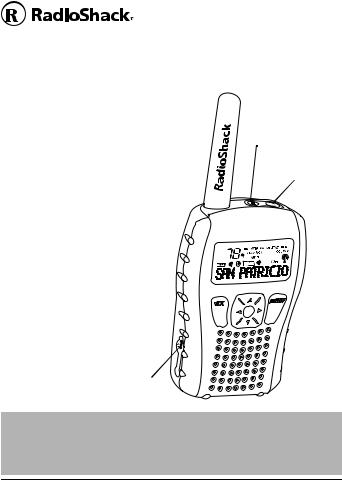Radio Shack 12-259 User Manual

Portable Handheld
|
www.radioshack.comSM |
NWR-SAME |
|
OWNER’S MANUAL — |
Weatheradio |
|
12-259 |
|
|
Please read before using this equipment. |
|
|
|
|
Thank you for buying the |
TR/HM — Select |
|
RadioShack Portable |
data receive |
|
Handheld NWR-Same |
modes: travel or |
|
Weatheradio . It uses |
home. |
|
Specific Area Message |
|
Encoding (SAME) circuitry to |
º — On/Off |
provide more complete |
|
information about weather |
|
conditions in your immediate |
|
area, letting you avoid hearing |
|
alerts for geographical areas |
|
that do not interest you. There |
|
are 10 location codes that can |
|
be programmed for multiple |
|
location warnings. The |
|
warnings are indicated by |
|
WARNING, STATEMENT, and |
|
WATCH. |
|
DC 6V Jack |
|
! IMPORTANT !
If an icon appears at the end of a paragraph, go to the box on that page with the corresponding icon for pertinent information.
Ô — Note
© 2003 RadioShack Corporation. All Rights Reserved. RadioShack and RadioShack.com are trademarks used by RadioShack Corporation.

Works Weatheradio‚ Your How
CONTENTS |
|
How Your Weatheradio |
|
Works ............................... |
2 |
Preparation ....................... |
3 |
Installing Batteries ........ |
3 |
Using AC Power ........... |
4 |
Power Up Reset ........... |
4 |
Turning Power |
|
On and Off .................... |
5 |
Attaching the Belt Clip .. |
5 |
Programming the |
|
Weatheradio ..................... |
6 |
Setting the Alarm .......... |
7 |
Setting the Clock .......... |
8 |
Selecting Temperature |
|
Display Mode ................ |
8 |
Selecting a Channel ..... |
9 |
Selecting Alert Mode .. |
10 |
Enabling/Disabling Missed |
|
Alert Reminder ............ |
11 |
Enabling/Disabling Signal |
|
Loss Reminder ........... |
13 |
Understanding the FIPS |
|
Code ........................... |
13 |
Response Location |
|
Selection ..................... |
15 |
Enabling/Disabling Alert |
|
Tones .......................... |
17 |
Receiving Weather Alerts |
20 |
Viewing Signal |
|
Strength ...................... |
21 |
Locking Key ................ |
21 |
Selecting Travel |
|
/Home Mode ............... |
21 |
Troubleshooting ............. |
23 |
FCC Declaration of |
|
Conformity ...................... |
25 |
The FCC Wants |
|
You to Know ................... |
25 |
Care ............................... |
27 |
Specifications ................. |
27 |
HOW YOUR WEATHERADIO WORKS
Traditional weather radios simply receive the National Oceanic and Atmospheric Administration (NOAA) weather broadcast (usually within a 50mile radius), then sound an alarm if any emergency code was transmitted along with the broadcast. This means that people outside an affected area are often alerted even though their area is not affected, leading some to ignore weather warnings that apply to their own area.
In 1994, NOAA began broadcasting signals called FIPS (Federal Information Processing System) codes along with their standard weather broadcasts. These codes identify the type of emergency and the specific geographic (such as a country) information about the codes, so you can determine if the emergency might affect your area. Only SAMEcompatible weather radios are able to take advantage of this technology.
Each FIPS code identifies a specific geographic area defined by the National Weather Service (NWS), so
2

your Weatheradio sounds an alert only when a weather emergency is declared in that area. This helps you more efficiently track the weather conditions in and around your area.
PREPARATION
INSTALLING BATTERIES
1.Pull down the latch on the battery compartment cover and then remove the cover.
2.Install three AA batteries (not supplied) as indicated by the
polarity symbols (+ and –) marked inside.Ô.
3. Replace and secure the cover.
Full battery power is indicated on the display as j. When battery power is weak, ² appears. Further operations are not allowed until you replace the batteries. Ô
Ô BATTERY NOTES Ô
•Dispose of old batteries promptly and properly.
•Do not burn or bury batteries.
•Use only fresh batteries of the required size and recommended type.
•Do not mix old and new batteries, different types of batteries (standard, alkaline, or rechargeable), or rechargeable batteries of different capacities.
•If you do not plan to use the weatheradio for a month or more, remove the batteries. Batteries can leak chemicals that can damage electronic parts.
ÔNOTE Ô
•Be sure to turn off the power first and then replace the batteries in less than 1 minute as to keep the set clock time. If it takes more than 1 minute to replace, the clock time may be reset.
Preparation
3

Preparation
ÔNOTE Ô
The backlight is on when receiving an alert message, or for any key operation.
USING AC POWER
Your Weatheradio can also use 6V, 300mA AC/DC adapter with plug size H (not supplied) for normal operation. With AC connected, normal operation is allowed even if there are batteries in unit.
1.Open the rubber DC 6V jack cover.
2.Insert the AC/DC adapter’s barrel plug into DC 6V jack. Then plug the adapter into a standard AC outlet.
POWER UP RESET
When powered on for the first time after installing batteries, all LCD segments turn on for one second. The device starts to search for the best (strongest) weather channel. Reset the Weatheradio to default settings by following the steps below.Ô
1.Remove the batteries and/or disconnect AC power.
2.Hold down WX and re-insert
batteries or reconnect to AC power. Hold down WX until USER SETUP appears and a short beep sounds.
4

3.Release WX and press MENU. DEFAULT ON appears briefly, and then USER SETUP appears.
4.Remove batteries and/or disconnect AC power. Reinsert to begin use.
TURNING POWER ON AND OFF
Press and hold down G for two seconds to turn the Weatheradio on and off. Ô
ADJUSTING VOICE AND
TONE VOLUME
1.Press WX to turn on broadcast.
2.Repeatedly press e or d to adjust the volume to the desired listening level. VOLUME: and the volume level appear.
3.Press WX to turn off the weather broadcast.
4.Repeatedly press e or d to adjust the alert tone volume to the desired listening level. TONE VOL: and the alert tone level appear.
ÔNOTE Ô
If power is off, weather alert messages are not detected.
Preparation
5

Weatheradio‚ the Programming
ÔNOTE Ô
•The weatheradio does not receive alert signals during programming.
•If you press MENU or do not press a key for 45 seconds while programming, the weatheradio saves all valid entries you made and exits programming mode.
ATTACHING THE BELT CLIP
Insert the clip into the hole at the back of the weatheradio until it clicks. To remove the belt clip, press the button on the tip of the clip and pull it out.
ATTACHING THE WRIST
STRAP (NOT SUPPLIED)
Slide the wrist strap’s small loop under the bar at the back of the weatheradio. Then pull the strap’s large loop through the small loop and fasten it.
PROGRAMMING THE WEATHERADIO
Your Weatheradio is pre-programmed with seven NOAA broadcast frequencies (channels 1-7). Depending on your location, you might need to select a different channel.
Your Weatheradio is preset to receive any weather alert broadcast within about a 50 mile radius. The first time you use your Weatheradio , it scans for the strongest channel and receives all SAME alert signals broadcast within a 50 mile radius of its location. Ô
6

1.Press MENU. The following functions can be set:
SET ALARM |
SET CLOCK |
|
|
TEMPERATURE |
SELECT CH |
|
|
ALERT MODE |
ALT REMINDER |
|
|
SIG REMINDER |
AREA SELECT |
|
|
TONE DEFEAT |
|
|
|
2.Press e or d to scroll through functions. Press g to select a function to modify. Press f to go back to the previous mode or to exit.
SETTING THE ALARM |
|
||
1. |
Press MENU. Then press e and d |
|
|
|
until SET ALARM appears. |
|
|
2. |
Press g. É and alarm time appear. |
|
|
ÔNOTE Ô |
|||
|
The first time you activate the |
||
|
• Repeatedly press e |
||
|
alarm, the alarm time shows 12:00 |
||
|
AM. Ô |
or dto enable or |
|
|
|
disable the alarm. |
|
3. |
Press g. The hour digits flash. |
The alarm is enabled |
|
|
Repeatedly press e or d to set the |
with É on and |
|
|
desired hour. |
disabled with É |
|
|
flashing. |
||
|
|
||
4.Press g. The minute digits flash. Repeatedly press e or d to set the desired minutes.
7
Programming the Weatheradio‚

Weatheradio‚ the Programming
ÔNOTES Ô
Setting the Alarm
•The alarm duration is one hour under standby mode and is only five seconds during NWS alert broadcast.
Setting the Clock
•Hold down MENU to view the clock time during NWS alert broadcast.
5.Press g. AM or PM flashes. Repeatedly press e or d to make your selection.
6.Press gto confirm. One long beep sounds. Press MENU to exit.
At the set alarm time, the Weatheradio generates an alarm. Press any button to stop the alarm.Ô
SETTING THE CLOCK
1.Press MENU. Then press e or d until SET CLOCK and Ì appear.
2.Press g. The hour digits flash. Press e or d to set the hour.
3.Press g. The minute digits flash. Repeatedly press e or d to set the minutes.
4.Press g. AM or PM flashes. Repeatedly press e or d to choose the desired format.
5.Press g again to store the time. A long beep sounds to confirm the entry.
6.Press MENU to exit. Ô
8

SELECTING TEMPERATURE
DISPLAY MODE
1.Press MENU. Then press e or d until TEMPERATURE appears.
2.Press g. The current temperature reading flashes.
3.Press e or d to select the desired temperature display mode (°F or °C).
4.Press g to confirm the setting.
Press MENU to exit. Ô
SELECTING A CHANNEL
1.Press MENU. Then press e or d until SELECT CH appears.
2.Press g. Ô
3.To automatically search for channels, press g when AUTO appears. CHANNEL and SEARCHING …
appear. If there is an available channel, CHANNEL, and the number of the currently selected channels, and AVAILABLE appear. If there is no available channel, NO CHANNEL,
AVAILABLE, BACK TO CHANNEL, and the number of the last selected
ÔNOTE Ô
Selecting Temperature Display Mode
The current temperature is updated about every 30 seconds.
Selecting a Channel
•If Auto mode was selected previously,
AUTO appears. If Manual mode was
selected previously, MANUAL appears.
•During manual channel selection, the weather broadcast turns on so that you can verify a station exists on the selected channel.
•The Weatheradio automatically searches for and tunes to the strongest weather broadcast channel in your area if you select AUTO.
9
Programming the Weatheradio‚
